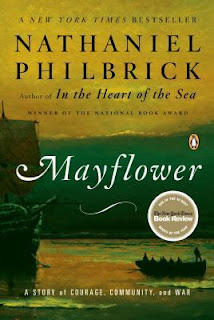480
pages, Penguin Books, ISBN-13: 978-0143111979
I
think it's safe to say that most Americans are now aware that the myths of our
nation's origins cover over more than a little of the brutality of the process.
Yet many of us don't know the details of the encounters whose echoes are still
heard down the long halls of history. Nathaniel Philbrick's Mayflower: A Story of Courage, Community,
and War goes a long way toward illuminating a seemingly familiar corner of
American history, filling in the shadows with tales of heroes and scoundrels
from both sides of the encounter. Philbrick mainly covers the period from 1620
(the year the Pilgrims sailed) through 1676 (the end of the bloody work of
extermination known as King Philip's War). This is roughly the period of the
Pilgrims, their children and grandchildren. Yet while the period ended in a
brutal mostly one-way slaughter, it also enshrined a 56-year period of relative
peace, in which the two sides, ever needful of each other, managed to live in a
version of harmony.
Indeed,
Mayflower is full of noble acts and
savagery by both sides. The cohesiveness and piety of the Mayflower passengers
both propelled them to the New World, and kept them together and sane once they
arrived. The great sachem Massasoit, for his part, is depicted as moving beyond
fear and prejudice to ally himself to the new colonists. For their part, the
Pilgrims produced great leaders and diplomats like William Bradford and Edward
Winslow who were able to keep the colony secure in spite of the terrifying
newness that surrounded it. But scoundrels abounded as well. Miles Standish is
portrayed as a genocidal maniac who delighted in killing Indians. The
Wessagusset raid that he led is depicted in all of its duplicity, manic
violence and betrayal of hospitality. Squanto, the Indian who helped the Pilgrims
survive their first winter, is shown using the Pilgrims to advance his own
leadership ambitions. Later in the saga, we are introduced to cowardly and
ineffective King Philip, stalwart and humane Benjamin Church, doughty Indian
captive Mary Rowlandson, cautious female sachem Weetamoo, warrior and praying
Indians, and more. By the end of the tale, you will have become acquainted with
John Alden and Roger Williams and comprehend what brought them to Plymouth and
what drove them from it. You will learn the difference between Pilgrims and
Puritans, Pokonokets and Narragansetts, sachems and powwows, flintlocks and
matchlocks. And you will have witnessed a strange and wonderful tableau of the
"first Thanksgiving" in 1621, including naked Indians and meat
pottages boiling over open fires. You will also gain an appreciation of the
mentality in 17th century New England that allowed such a horror as King
Philip's war to break out. You'll understand how the Indian way of war was so
different from the more lethal English variety.
For
all the recent focus on the treachery and savagery of Europeans, I appreciated
Philbrick's attempt to focus on the positive and peaceful coexistence of the
two sides from the 50-odd years following the Pilgrims’ arrival. However
fleeting and tenuous that peace might have been, it stands as a testament to
the possibility that recognition of mutual humanity and need can forge a
relationship among the most divergent of cultures.

No comments:
Post a Comment